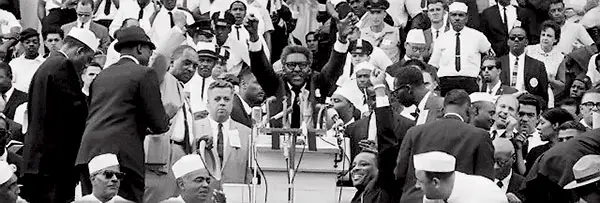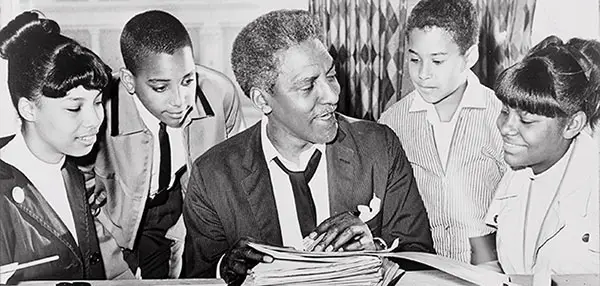Hello! Welcome To My Blog! This blog is 4 A Unique Person who likes 2 learn more about different topics,2 listen 2 cool music,2 Bright everyday with nice messages,2 Let the Inner child inside come out once in a while,& 2 support small business like my Store Unique As U R. Enjoy My Blog!! I know I do!
Saturday, September 26, 2015
ANOTHER HERO
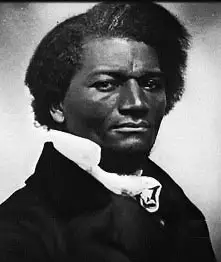 Frederick was hired out to William Freeland and spent time among Freeland’s slaves. Frederick decided that he would help the other slaves to learn as had he and began teaching them to read the Bible at a weekly Sunday school service. Much like him, the other slaves became enamored with learning. Weeks later, neighboring plantation owners learned what Frederick was doing and threatened to beat all of the slaves attending the next Sunday school meeting.
Frederick was hired out to William Freeland and spent time among Freeland’s slaves. Frederick decided that he would help the other slaves to learn as had he and began teaching them to read the Bible at a weekly Sunday school service. Much like him, the other slaves became enamored with learning. Weeks later, neighboring plantation owners learned what Frederick was doing and threatened to beat all of the slaves attending the next Sunday school meeting.
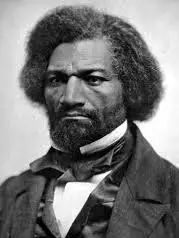 Douglass became a staunch abolitionist and joined several anti-slavery organizations and subscribed to “The Liberator,” the weekly journal authored by abolitionist William Lloyd Garrison. Douglass was so taken with Garrison’s words that he later stated that “his paper (The Liberator) took a place in my heart second only to the Bible.” Garrison was likewise impressed with Douglass, and he wrote about him in the Liberator and soon the two began speaking at anti-slavery meetings in New York and Massachusetts. Douglass, though only 23 years of age, was invited to speak about his time as a slave in front to the Massachusetts Anti-Slavery Society’s annual convention in Nantucket, Massachusetts.
Douglass became a staunch abolitionist and joined several anti-slavery organizations and subscribed to “The Liberator,” the weekly journal authored by abolitionist William Lloyd Garrison. Douglass was so taken with Garrison’s words that he later stated that “his paper (The Liberator) took a place in my heart second only to the Bible.” Garrison was likewise impressed with Douglass, and he wrote about him in the Liberator and soon the two began speaking at anti-slavery meetings in New York and Massachusetts. Douglass, though only 23 years of age, was invited to speak about his time as a slave in front to the Massachusetts Anti-Slavery Society’s annual convention in Nantucket, Massachusetts.
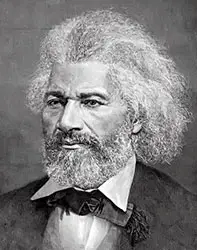
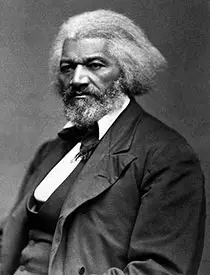 The honors and accolades that Douglass received after his death are numerous. Several schools and bridges have been named after him and his home in the Anacostia section of Washington, DC became part of the National Park system. Likewise, Douglass Place, the property on which he built rental units is listed on the National Register of Historic Places. In 1965, the United States Postal Service honored him with a stamp and in 1999, Yale University established the Frederick Douglass Book Prize for works dealing with abolition and the history of slavery. In 2010 a statue of him and a memorial were erected at the northwest corner of Central Park in New York City and the same year he was inducted into the inaugural class of the New York Writers Hall of Fame.The County of Talbot in Maryland erected a seven foot tall statue of him outside of the courthouse in Easton, Maryland in June 2011 and West Chester University created the Frederick Douglass Institute, a multicultural program focusing on his heritage. In June 2013, a statue of Douglass was unveiled in the United States Capitol Visitor Center and in September of 2014, Maryland Governor Martin O’Malley unveiled a portrait of Douglass in the Governors residence, the first African-American portrait to hang there.
The honors and accolades that Douglass received after his death are numerous. Several schools and bridges have been named after him and his home in the Anacostia section of Washington, DC became part of the National Park system. Likewise, Douglass Place, the property on which he built rental units is listed on the National Register of Historic Places. In 1965, the United States Postal Service honored him with a stamp and in 1999, Yale University established the Frederick Douglass Book Prize for works dealing with abolition and the history of slavery. In 2010 a statue of him and a memorial were erected at the northwest corner of Central Park in New York City and the same year he was inducted into the inaugural class of the New York Writers Hall of Fame.The County of Talbot in Maryland erected a seven foot tall statue of him outside of the courthouse in Easton, Maryland in June 2011 and West Chester University created the Frederick Douglass Institute, a multicultural program focusing on his heritage. In June 2013, a statue of Douglass was unveiled in the United States Capitol Visitor Center and in September of 2014, Maryland Governor Martin O’Malley unveiled a portrait of Douglass in the Governors residence, the first African-American portrait to hang there.
http://www.greatblackheroes.com/civil-rights/frederick-douglass/
Frederick Douglass was the most well-known Black person in America as he bravely fought for the cause of the abolishment of slavery in the United States.
Frederick Augustus Washington Bailey was born in Talbot County, Maryland, on the Eastern Shore of the Chesapeake Bay. He was born a slave, the son of Harriet Bailey and an unknownn white man, presumably his master. His birthdate and year are unknown although he celebrated it on February 14th. He was believed to be of mixed race, with African, European and Native American blood flowing through his veins. As was often the custom in parts of the south, he was separated from his mother at an early age and only had vague memories of her. He was thereafter raised by his maternal grandmother until they too were separated. He was eventually sent to live with Hugh Auld, a ship carpenter, in Baltimore, Maryland.
It was while living with the Aulds that he began to learn, as Hugh’s wife Sophie began to teach him the alphabet. It was against the law in Maryland to teach a slave to read, but Sophie thought it important to teach young Frederick. Hugh, on the other hand, was very much against teaching him to read, believing that if a slave was taught to read and think that it would prompt him to desire his freedom. He thus admonished her not to teach him any further but Frederick, being very bright, paid attention to other children reading as well as his co-workers when he got older.
"Knowledge is the pathway from slavery to freedom."
— Frederick Douglass
Frederick continued to educate himself, sneaking to read anything he could get his hands on. As he became more learned, he began to question the institution of slavery, much as Hugh Auld had warned. His main source of inspiration for his thinking was an anthology entitled “The Columbian Orator” which was published in 1797. It contained many essays and speeches and it lit him afire with a passion for learning, philosophy and self-direction.
 Frederick was hired out to William Freeland and spent time among Freeland’s slaves. Frederick decided that he would help the other slaves to learn as had he and began teaching them to read the Bible at a weekly Sunday school service. Much like him, the other slaves became enamored with learning. Weeks later, neighboring plantation owners learned what Frederick was doing and threatened to beat all of the slaves attending the next Sunday school meeting.
Frederick was hired out to William Freeland and spent time among Freeland’s slaves. Frederick decided that he would help the other slaves to learn as had he and began teaching them to read the Bible at a weekly Sunday school service. Much like him, the other slaves became enamored with learning. Weeks later, neighboring plantation owners learned what Frederick was doing and threatened to beat all of the slaves attending the next Sunday school meeting.
In 1933, Frederick returned to Thomas Auld, Hugh’s brother. Thomas had been Frederick’s real owner and he sent him off to work for a farmer named Edward Covey. Covey was well known with a reputation for beating slaves and breaking their wills. Thomas must have wanted to break Frederick’s spirit, so Covey beat the young teenager frequently. While the brutal whippings took their toll on his psychologically, he was a strong young man and eventually fought back against Covey, after which the beatings ceased. Without the care of his mother and grandmother and even Sophie Auld, Frederick developed a deep hatred for his bondage and became determined to escape from it. He first tried to escape from William Freeland and then later from Covey in 1836.
In 1837 he began a relationship with Anna Murray who was from Baltimore, Maryland. She was a free woman of color and was five years older than him. The thought of being a slave married to a free woman was too much for him and he decided to try another escape attempt. On September 3, 1838 he jumped aboard a Philadelphia, Wilmington & Baltimore train headed north and got off in Havre de Grace, Maryland. Rather than continue on the train which would have taken him to Pennsylvania, a free state, he got off in Havre de Grace and ventured across Delaware, another slave state. The journey across Delaware was very short and using a sailor’s uniform and money provided by Anna and identification papers that he obtained from a free Black seaman, he rode a steam-ferry to Perryville, Maryland and then a train to Wilmington, Delaware. He then caught a steamboat across the Delaware River until he finally reached Philadelphia, Pennsylvania, one of the most stridently anti-slavery states in the country. He continued on until he reached the safe house of abolitionist David Ruggles in New York City. The nerve-racking trip took just under 24 hours and he rejoiced about gaining his freedom”
"I have often been asked, how I felt when first I found myself on free soil. And my readers may share the same curiosity. There is scarcely anything in my experience about which I could not give a more satisfactory answer. A new world had opened upon me. If life is more than breath, and the ‘quick round of blood,’ I lived more in one day than in a year of my slave life. It was a time of joyous excitement which words can but tamely describe. In a letter written to a friend soon after reaching New York, I said: ‘I felt as one might feel upon escape from a den of hungry lions.’ Anguish and grief, like darkness and rain, may be depicted; but gladness and joy, like the rainbow, defy the skill of pen or pencil."
— Frederick Douglass
As soon as he was able to, he sent for Anna and she joined him in New York where they were married on September 15, 1838, less than two weeks after his escape. They initially took the name Johnson but adopted the last name Douglass after they moved to New Bedford, Massachusetts, which had a thriving free black community. The couple would eventually have five children, three boys and two girls. The couple joined the African Methodist Episcopal Zion Church and Frederick became a licensed minister in 1839. This would begin his times as a public speaker and in 1840 he gave a speech in Elmira, New York, one of the stops on the Underground Railroad.
 Douglass became a staunch abolitionist and joined several anti-slavery organizations and subscribed to “The Liberator,” the weekly journal authored by abolitionist William Lloyd Garrison. Douglass was so taken with Garrison’s words that he later stated that “his paper (The Liberator) took a place in my heart second only to the Bible.” Garrison was likewise impressed with Douglass, and he wrote about him in the Liberator and soon the two began speaking at anti-slavery meetings in New York and Massachusetts. Douglass, though only 23 years of age, was invited to speak about his time as a slave in front to the Massachusetts Anti-Slavery Society’s annual convention in Nantucket, Massachusetts.
Douglass became a staunch abolitionist and joined several anti-slavery organizations and subscribed to “The Liberator,” the weekly journal authored by abolitionist William Lloyd Garrison. Douglass was so taken with Garrison’s words that he later stated that “his paper (The Liberator) took a place in my heart second only to the Bible.” Garrison was likewise impressed with Douglass, and he wrote about him in the Liberator and soon the two began speaking at anti-slavery meetings in New York and Massachusetts. Douglass, though only 23 years of age, was invited to speak about his time as a slave in front to the Massachusetts Anti-Slavery Society’s annual convention in Nantucket, Massachusetts.
In 1843, Douglass embarked upon a six month tour along with other speakers as part of the American Anti-Slavery Society’s “Hundred Conversion” project. The tours traveled throughout the Midwest and the Northeast, drawing attention to the plight of those held in captivity. For abolitionist speakers, the reception was often hostile. For Douglass, it almost cost him his life as he was often confronted violently and once suffered a broken hand when he was attacked by an angry mob in Pendleton, Indiana. He was rescued by a local Quaker family, but his hand never fully healed properly, though it did not slow him down.
In 1845, Douglass decided to publish his autobiography in order to give an account of his years in subjugation to a wider audience. The book was entitled “Narrative of the Life of Frederick Douglass, an American Slave.” The book became a best seller though critics and skeptics insisted that it must have been ghost-written, arguing that a Black person could not have written so eloquently.
As Douglass became more well-known, his confidantes feared that his growing stature and notoriety might draw the attention of his owners Thomas and Hugh Auld, who might try to bring him back into captivity. They convinced him to help to drum up support for the abolitionist movement outside of the United States. He traveled to Ireland and Britain, speaking in places of worship for more than two years. During his travels he met with many abolitionists and some of his supporters in Britain, led by Ellen Richardson, got together and purchased his freedom from Thomas Auld. Though he was coaxed to continue on with his work in Britain, he returned to the United States in the spring of 1847.
Upon his return to the United States, Douglass decided to follow in the path of William Lloyd Garrison and became a newspaper publisher. His newspaper, “the North Star” was produced in the basement of the AME Zion Church in Rochester, New York, and carried with it the banner “Right is of no Sex – Truth is of no Color – God is the Father of us all, and we are all brethren.” Having gained a greater voice, Douglass soon came into conflict with other abolitionist groups. He denounced the American Colonization Society which advocated freeing the slaves and sending them back to Africa and he even came into conflict with Garrison, whom he considered too radical. Garrison believed that the United States Constitution was a pro-slavery document because it counted Black slaves as only 3/5 of a person for voting representational purposes and because many compromises were negotiated into it which allowed slavery to continue. Douglass, on the other hand was convinced that the Constitution laid the groundwork for ending slavery.
In 1848, Frederick attended the Seneca Falls Convention in New York, the only Black person attending. When a motion was made by Elizabeth Cady Stanton to pass a resolution to ask for women’s suffrage, Douglass announced that he was in favor of such a resolution, stating that it would not be fair for him to vote as a Black man if women were not also provided the same right.
"In this denial of the right to participate in government, not merely the degradation of woman and the perpetuation of a great injustice happens, but the maiming and repudiation of one-half of the moral and intellectual power of the government of the world. "
— Frederick Douglass
The resolution was thereafter passed. He continued to press for the rights of women, both in speaking engagements and in the North Star. He backed away, somewhat later, when women’s right advocates sought to press the cause of Blacks and women together in regard to the impending passage of the 15th Amendment which proposed to give Black men the right to vote. Douglass feared that including women in the discussions could derail and fracture the narrow support for the amendment.
Douglass merged his North Star newspaper with Gerrit Smith’s “Liberty Party Paper” in 1851 and the new entity was called “Frederick Douglass’ Paper” which would run for another nine years and in 1855, Douglass published another autobiography entitled “My Bondage and My Freedom.”
Despite his thoughts on the 15th Amendment, Frederick continued to speak out in favor of the rights of women and the rights of Blacks. His speech before the Rochester Anti-Slavery Sewing Society is remembered by many as one of his greatest speeches. He advocated the desegregation of educational facilities, arguing that education was one of the most fundamental needs of the Black community and that the disparity between white schools and Black schools created a roadblock.
At around this time in the autumn of 1859, Douglass was approached by John Brown, the virulent abolitionist. Brown devised a plan to raid the Federal armory in Harpers Ferry, West Virginia and to distribute the weapons therein to slaves and abolitionists across the country. His plan to overthrow the slave south was too risky for Douglass, who believed the attack on federal property would turn the American public against the abolitionist movement. The raid was unsuccessful and Frederick felt that by guilt through association, his safety might be at risk and he fled to Canada. A year later, while he was traveling in England, Douglass was informed that his youngest daughter Annie had passed away in Rochester. He traveled back to attend to her services.
Upon the beginning of the American Civil War, Douglass advocated on behalf of Blacks wanting to fight in a war for their freedom. He spoke publicly and through print on this issue and was invited by President Abraham Lincoln to sit down and discuss the matter. It could be argued that having the ear of the President made Douglass the most powerful Black man in the country. He talked to Lincoln about the role and the treatment of the Black soldier and later spoke with Andrew Johnson about Black voting rights.
When President Lincoln announced the Emancipation Proclamation, it freed the slaves being held in the Confederate territories but it did not affect Slaves in Union-held and Northern states. They would not be freed until the passage of the 13th Amendment on December 6, 1865. Douglass described the anticipation: “We were waiting and listening as for a bolt from the sky … we were watching … by the dim light of the stars for the dawn of a new day … we were longing for the answer to the agonizing prayers of centuries.”

Although Lincoln had met with Douglas, it did not mean that Frederick was beholden to him and he demonstrated this by voting for John C. Fremont in the 1864 President election. He chose not to vote for Lincoln because the President had failed to endorse suffrage for Black freedmen, especially when Blacks were fighting in the war. Nevertheless, he worked with Lincoln to develop a plan to move Blacks out of the south and into northern cities. He further supported the war effort by serving as a recruiter for the 54th Regiment Massachusetts Volunteer Infantry, in which his son Charles served. His son Lewis fought at the Battle of Fort Wagner and his son Frederick, Jr., also served as a recruiter.
Douglass seemed to have fluctuating opinions of the “Great Emancipator.” In one instance he would refer to Lincoln as “America’s greatest President.” In another, notably the 1876 unveiling of the Emancipation Memorial in Washington, DC, Douglass referred to Lincoln as “the white man’s President.” He lamented that Lincoln took so long to call for the abolishment of slavery but then said “Though Mr. Lincoln shared the prejudices of his white fellow-countrymen against the Negro, it is hardly necessary to say that in his heart of hearts he loathed and hated slavery.”
After the Civil War, the country enter the time of Reconstruction where the Confederate states were rebuilt into members of the Union. Douglass was in great demand and was offered numerous jobs and political positions. We was appointed to the position of president of the Reconstruction-era Freeman’s Savings Bank and later the chargé d’affaires for the Dominican Republic (although he resigned from the position two years later over objections to United States policies). Because of the growing power of the Democrats in the former confederate states as well as the lawlessness on the part of southern vigilantes, southern Blacks found themselves in much the same situation in which they had previously been, denide opportunities to vote and lead normals live. Because of the this, Douglass joined with many republicans in backing Ulysses Grant’s run for the Presidency. After he was elected Grant signed into law the Civil Rights Act of 1871 and the Enforcement Acts, meant to prevent the abuse against Blacks in the south. Douglass supported these efforts, using his new newspaper, “the New National Era,” to hold the President and Congress’ feet to the fire. Grant was true to his word and his actions led to more than 5,000 arrests garnering much praise from Douglass.
In 1872, Frederick’s reputation even led to him being nominated for the position of Vice-President on the Equal Rights Party ticket, alongside of Victoria Woodhull. He had no interest in the position and just busied himself with publishing his newspaper. Unfortunately, later that year, his house in Rochester was burned to the ground with arson suspected. He left New York and moved down to Washington, DC. He continued going around the country speaking out in favor of the rights of free Blacks and for the rights of women.
In 1874, Douglass suffered two disappointments as his newspaper “The New Era” went out of business and the Freedman’s Savings Bank went bankrupt. However, he landed on his feet when he was appointed as United States Marshall for the District of Columbia by President Rutherford B. Hayes. 1877 brought about a unique reunion for him. After Amanda Auld Sear attended one of his speeches, she coaxed Frederick to return to meet with Thomas Auld, his former master. Then on his deathbed, Thomas had changed over the years and the two men reconciled. With the financial security of his position as a US Marshall, Frederick felt comfortable in buying a large house in Washington, DC for his family. Already a huge house, he and Anna expanded it from 14 rooms to 21 rooms.
In 1881, Frederick published his final autobiography entitled “Life and Times of Frederick Douglass” and was appointed as the Recorder of Deeds for the District of Columbia. However, the next year was crushing to him as Anna, his dear wife of 44 years, passed away. Two years later though, he married Helen Pitts, a feminist and graduate of Mount Holyoke College, and the daughter of his friend Gideon Pitts, Jr.. Because she was white and 20 years younger than him, their marriage spawned a whirlwind of criticism, but Douglass merely pointed out that his first marriage was to someone the color of his mother, and his second to someone the color of his father.
He continued his public speaking and traveled across the United States and overseas and in 1888 at the Republican National Convention, a vote was cast for him to be the nominee for the Presidency of the United States. A year later, he was appointed the Minister-Resident and Consul-General by the Republic of Haiti and a few years later he built rental properties for Black in Baltimore called Douglass Place.The buildings still stand to this day and have been listed on the National Register of Historic Places.
After attending a meeting for the National Council of Women in Washington, DC, Frederick Douglass died at his home on February 20, 1895. The cause of death was believed to have been either a massive dart attack or a stroke. He was buried at Mount Hope Cemetery in Rochester, New York next to Anna. His second wife Helen would be buried beside him years later.
 The honors and accolades that Douglass received after his death are numerous. Several schools and bridges have been named after him and his home in the Anacostia section of Washington, DC became part of the National Park system. Likewise, Douglass Place, the property on which he built rental units is listed on the National Register of Historic Places. In 1965, the United States Postal Service honored him with a stamp and in 1999, Yale University established the Frederick Douglass Book Prize for works dealing with abolition and the history of slavery. In 2010 a statue of him and a memorial were erected at the northwest corner of Central Park in New York City and the same year he was inducted into the inaugural class of the New York Writers Hall of Fame.The County of Talbot in Maryland erected a seven foot tall statue of him outside of the courthouse in Easton, Maryland in June 2011 and West Chester University created the Frederick Douglass Institute, a multicultural program focusing on his heritage. In June 2013, a statue of Douglass was unveiled in the United States Capitol Visitor Center and in September of 2014, Maryland Governor Martin O’Malley unveiled a portrait of Douglass in the Governors residence, the first African-American portrait to hang there.
The honors and accolades that Douglass received after his death are numerous. Several schools and bridges have been named after him and his home in the Anacostia section of Washington, DC became part of the National Park system. Likewise, Douglass Place, the property on which he built rental units is listed on the National Register of Historic Places. In 1965, the United States Postal Service honored him with a stamp and in 1999, Yale University established the Frederick Douglass Book Prize for works dealing with abolition and the history of slavery. In 2010 a statue of him and a memorial were erected at the northwest corner of Central Park in New York City and the same year he was inducted into the inaugural class of the New York Writers Hall of Fame.The County of Talbot in Maryland erected a seven foot tall statue of him outside of the courthouse in Easton, Maryland in June 2011 and West Chester University created the Frederick Douglass Institute, a multicultural program focusing on his heritage. In June 2013, a statue of Douglass was unveiled in the United States Capitol Visitor Center and in September of 2014, Maryland Governor Martin O’Malley unveiled a portrait of Douglass in the Governors residence, the first African-American portrait to hang there.
Frederick Douglas was more than just an abolitionist speaker. He took the plight of slaves on his back and championed their freedom to the world, disregard his personal safety and liberty. In a time when Blacks had almost no voice, he had the ear of the masses.
BLACK AMERICAN HEROES U MAY DO NOT KNOW ABOUT
Bayard Rustin
Bayard Rustin spent years in the background of the shadows of the great civil rights leader of the 1960′s, despite being the man who taught, organized and led them.
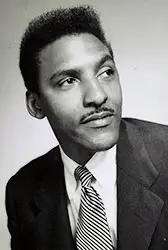
Bayard Rustin was born on March 17, 1912 in West Chester, Pennsylvania. His father was a West Indian immigrant named Archie Hopkins and his mother was Nancy Rustin. Until he was in his teens he believed that Nancy was his sister as he was raised by Nancy’s parents. His grandfather Janifer Rustin was a member of the local African Methodist Episcopal church but his grandmother Julia had been raised a Quaker and much of the Quaker philosophy guided him throughout his years. The Rustins were socially active in the NAACP and in Black civil right causes and counted among their personal friends such dignitaries as James Weldon Johnson and W.E.B. DuBois whom they entertained in their home. This association with notable figures and discussions of the rights of people lead him to engage in activism at an early age.
Bayard attended Wilberforce University, an historically black college in Ohio operated by the AME Church. He was active in extra-curricular activities on campus, including membership in the Omega Psi Phi fraternity and in musical programs (he had received a music scholarship), but he left the school after four years without completing his exams. He later attended Cheyney State Teachers College in Pennsylvania. He became affiliated with the American Friends Service Committee, aQuaker affiliated organization which worked for peace and social justice in the United States and around the world. He participated in one of the groups activist training programs and then moved to Harlem, New York in 1937 and enrolled in the City College of New York soon thereafter . He had become a member of the Communist Youth League the previous year and joined with the Communist movement in trying to free the Scottsboro Boys, a group of nine Black men unfairly accused of raping two white women in Alabama. In later years, his communist affiliation would come back to haunt him but in the 1930′s, communist organizations were often the only ones who tried to help Black people in civil rights matters. He was also a member of the Quaker group The Religious Society of Friends. His life was a flurry of activity, especially when one considers his age at the time. In addition to his activism, he still dabbled in music where he was considered an accomplished tenor vocalist and sang on occasion with Paul Robeson. He was later a member of the Josh White and the Carolinians band, which played gigs in the Cafe Society nightclub in the trendy Greenwich Village. Years later he would record a 10-inch LP for Fellowship Records on which he sang.
During World War II, the United States engaged in the very controversial program of Japanese-American internment. Leery of spies for the Empire of Japan existing on the west coast of the United States, President Roosevelt authorized the incarceration of approximately 120,000 people of Japanese descent in government internment camps, despite the fact that two-thirds of them were American citizens. Rustin took up the cause to help to protect the property belonging to the internees while they were kept in the camps. His talents were again impressive to Muste and he invited Bayard to serve as the FOR’s Secretary for Student and General Affairs, a position which Rustin accepted.
At around the same time, Bayard travelled by bus from Louisville, Kentucky to Nashville, Tennessee and he sat in the second row of the bus. He was asked by several drivers to get out of his seat and move to the back of the bus so a white person could sit in it, a practice common on buses in the south. When Bayard refused, he was arrested miles before his destination, and was beaten by the police and dragged off to jail. He was released without charges but his act of defiance happened in 1942, a full 13 years before Rosa Parks gained fame through her similar refusal. This was not Bayard’s only brush with the law, however.
Consider as you are reading this that this was Black man, taking on national and world issues during the post-war United States. Consider also that this was the period in which the Cold War would start pitting the United States, now considered the world leader in democracy, against the Soviet Union, the dominant force of communism in the world. For Rustin, (a former communist and now socialist) to be taking on the United States and British government could seem to be reckless to his personal well-being as well as political suicide for his reputation. Finally consider that he was a homosexual in the conservative years of the Truman and Eisenhower administrations and it is almost unimaginable, the level of determination, confidence and bravery that he possessed in battling the system when he faced the possibility of personal attacks on so many fronts.
In 1947 Rustin joined with CORE founder George Houser in organizing the Journey of Reconciliation. It was non-violent form of direct action challenging segregation laws on interstate buses in the American south. One year earlier, the U.S. Supreme Court ruled in Irene Morgan vs. Commonwealth of Virginia that segregation in interstate travel violated the Constitution of the United States. Some of the southern states were refusing to comply with the Court’s ruling so the Journey of Reconciliation was devised as a way to directly challenge the segregation and provoke a response from southern law enforcement and legislators. Sixteen male members of CORE were recruited to ride throughout the upper south, composed of eight Black men and eight white men. They ranged in profession from biologist to social worker to student. On the rides, the Black men rode in the front of the bus and the whites rode in back, with Blacks and white sitting next to each other on occasion. Several of the riders were arrested including Rustin, who served 22 days on a chain gang. The white riders faced even worse punishments. North Carolina Judge Henry Whitfield told the white men involved:
“It’s about time you Jews from New York learned that you can’t come down here bringing your niggers with you to upset the customs of the South. Just to teach you a lesson, I gave your black boys thirty days [on a chain gang], and I give you ninety.”
The Journey of Reconciliation was a precursor not only to the Freedom Rides that would take place more than a decade later but also to the other direct action protests that helped to launch the Cilvil Rights movement of the 1960′s (lunch counter demonstrations and enrollment in public state university for instance).
In 1948, Bayard travelled to India to get hands on training in the concept of non-violent civil resistance. He learned directly from the disciples of Gandhi was had been murdered earlier in the year. Over the next few years he travelled to numerous countries, helping to develop movements to promote independence. He also created the Committee to Support South African Resistance in 1951.
In spite of his growing stature in the field of civil rights, Rustin hit roadblock in 1953 that could have derailed the rest of his career. He was arrested in Pasadena, California and charged with vagrancy and lewd conduct after he was found in a car with two men. He plea bargained and served 60 days in a California jail. Soon thereafter he was fired by the Fellowship of Reconciliation, but was hired by the War Resisters League to serve as the organization’s executive secretary. In 1955 he anonymously contributed to the American Friends Services Committees’ publication “Speak Truth to Power: A Quaker Search for an Alternative to Violence.” The 71 page pamphlet analyzed the Cold War, positing non-violent alternatives and was widely acclaimed as one of the most highly recommended pacifist essays.
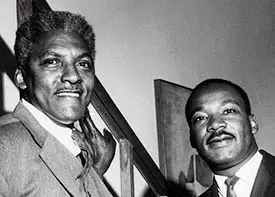 In 1956, Bayard made a decision that would help to change American history. He had become aware of the rising popularity of Dr. Martin Luther King, Jr. and his work in leading the Montgomery Bus Boycott. He sought out the 25 year old King to impress upon him the need to utilize a strategy of non-violent action in regard to protests. At the time, Dr. King was protected by armed bodyguards and he kept a person handgun in his home. Rustin taught King many of the philosophies that he had learned from his experiences in India learning from Ghandi’s disciples. King eventually saw the merit in the non-violence philosophy and the two began working closely together. In January 1957, Rustin worked with King as well as Joseph Lowery, Fred Shuttlesworth, and Ralph Abernathy and founded the Southern Christian Leadership Conference.
In 1956, Bayard made a decision that would help to change American history. He had become aware of the rising popularity of Dr. Martin Luther King, Jr. and his work in leading the Montgomery Bus Boycott. He sought out the 25 year old King to impress upon him the need to utilize a strategy of non-violent action in regard to protests. At the time, Dr. King was protected by armed bodyguards and he kept a person handgun in his home. Rustin taught King many of the philosophies that he had learned from his experiences in India learning from Ghandi’s disciples. King eventually saw the merit in the non-violence philosophy and the two began working closely together. In January 1957, Rustin worked with King as well as Joseph Lowery, Fred Shuttlesworth, and Ralph Abernathy and founded the Southern Christian Leadership Conference.
Through all of his work, Rustin had gained a number of highly influential friends in the civil rights movement, but he gained a number of enemies as well and they were not above using his sexual orientation or his communist past against him. Rustin had been very candid about his sexual orientation and his arrest in California was a matter of public record but most of the general public was unaware of it. This changed in 1960 as Rustin and King were pushing for a stronger civil rights platform at the 1960 Democratic Convention, planning a boycott of it by the followers. Adam Clayton Powell, Jr., then the most powerful Black politician in the United States heard about this he was furious, in part because he felt that King’s ascension in the political world would undermine his own power and influence. He threatened to expose Rustin’s past to the general public and further threatened to accuse King and Rustin of having a sexual affair if they did not call an end to the demonstration. King caved in to the threat and asked Rustin to resign from the movement. Rustin did so for the sake of the movement and was relegated to working behind the scene for years to come. Despite Powell’s blackmailing of him, years later Rustin would come to the Congressman’s aid when the House of Representatives sought to impeach Powell. It was not the last time that his past would be used against him and against the civil rights movement.
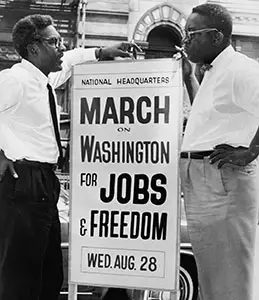 In 1963, Rustin and A. Philip Randolph announced the they were going to organize a demonstration in the Nation’s Capitol, Washington, DC. They recruited unions to support and participate in the march and got varying levels of support. They then reached out to the Council for United Civil Right Leaders, represented by the heads of the six major civil rights organizations, including: Randolph, the head of the Brotherhood of Sleeping Car Porters, James Farmer, the head of CORE, John Lewis, the chairman of the Student Nonviolent Coordinating Committee, King, then the head of the SCLC, Roy Wilkins, president of the NAACP and Whitney Young, the president of the National Urban League. At the outset, Wilkins and Young spoke out against Rustin heading the march effort, worried about his past being used to sabotage the effort. The decision was made therefore, for Randolph to lead the march and Rustin was relegated to the position of deputy organizer. That position was in name only as Rustin had a hand in everything, from the mobilization of publicity campaigns and recruitment of marchers, to arranging the bus schedules, to selecting the order for the speakers, to deciding on the number of bathroom to secure for the event.
In 1963, Rustin and A. Philip Randolph announced the they were going to organize a demonstration in the Nation’s Capitol, Washington, DC. They recruited unions to support and participate in the march and got varying levels of support. They then reached out to the Council for United Civil Right Leaders, represented by the heads of the six major civil rights organizations, including: Randolph, the head of the Brotherhood of Sleeping Car Porters, James Farmer, the head of CORE, John Lewis, the chairman of the Student Nonviolent Coordinating Committee, King, then the head of the SCLC, Roy Wilkins, president of the NAACP and Whitney Young, the president of the National Urban League. At the outset, Wilkins and Young spoke out against Rustin heading the march effort, worried about his past being used to sabotage the effort. The decision was made therefore, for Randolph to lead the march and Rustin was relegated to the position of deputy organizer. That position was in name only as Rustin had a hand in everything, from the mobilization of publicity campaigns and recruitment of marchers, to arranging the bus schedules, to selecting the order for the speakers, to deciding on the number of bathroom to secure for the event.
Bayard helped to navigate through the turmoil surrounding the event. There were disagreements between the organizers on what levels of civil disobedience would take place, with many thinking that the goals of the march were too weak. Finally, a consensus was born and the organization agreed on a set of goals:
- Passage of meaningful civil rights legislation;
- Immediate elimination of school segregation;
- A program of public works, including job training, for the unemployed;
- A Federal law prohibiting discrimination in public or private hiring;
- A $2-an-hour minimum wage nationwide;
- Withholding Federal funds from programs that tolerate discrimination;
- Enforcement of the 14th Amendment to the Constitution by reducing congressional representation from States that disenfranchise citizens;
- A broadened Fair Labor Standards Act to currently excluded employment areas;
- Authority for the Attorney General to institute injunctive suits when constitutional rights are violated.
In the days proceeding the march, several participants including King and Wilkins received death threats and the Los Angeles Times received a bomb threat, stating that its headquarters would be blown up unless it printed a message on its front page calling President Kennedy a “Nigger Lover.”
Little by little things came together as the day approached, but many in Washington were determined to derail the demonstration. J. Edgar Hoover was convinced that the march was planned and run by the communist party and he passed information about Rustin’s past to segregationist Senator Strom Thurmond. Thurmond declared Rustin to be a “Communist, draft-dodger and a homosexual,” and tried to imply that Rustin and King were involved in a sexual relationship. Whereas many of the Black leaders had earlier tried to distance themselves and the movement away from Bayard, against a racist like Thurmond they were all allied and they closed ranks around Rustin and Thurmond’s bluster amounted to very little.
On the day before the march, saboteurs disabled the speaker systems set up for the crowd. Unable to get it repaired, Walter Fauntroy, a delegate to the United States Congress contacted Attorney General Bobby Kennedy requesting assistance saying “We have a couple hundred thousand people coming. Do you want a fight here tomorrow after all we’ve done?” The U.S. Army Signal Corps was dispatched to fix the system and had it repaired by the next day.
The March on Washington for Jobs and Freedom took place on August 28, 1963. In the days preceding the march, the ever confident Rustin began to have doubts about how many would attend, at one point saying he would be happy if 40,000 showed up. Instead, approximately 250,000 people attended the march, about 60,000 of them white. They marched from the Washington Monument to the Lincoln Memorial where music was played and speeches were made. The last speech was given by Martin Luther King and he addressed the crowd with his “I Have a Dream” speech. The event ended with Rustin reading aloud the list of goals and Randolph joining him to ask the attendees to keep up the fight for racial and economic equality.
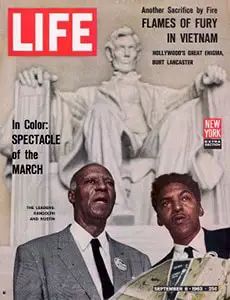 The legacy of the march was that it was looked at like a turning point in the minds of the American public. While many opponents predicted widespread crime and violence in the crowd of a quarter of a million people, none of the marchers was arrested that day. The sheer size of the organized crowd seeking equal rights let the country know that there was power behind the words and a growing mass of people whose voices would be heard one way for another. For Rustin, the march was more successful than he could have dreamed, despite his presence and contributions being marginalized. He need not have worried about history forgetting him though as the September 6, 1963 issue of Life Magazine featured him alongside A. Philip Randolph in a photograph in front of the Lincoln Memorial, identifying them as the leaders of the march.
The legacy of the march was that it was looked at like a turning point in the minds of the American public. While many opponents predicted widespread crime and violence in the crowd of a quarter of a million people, none of the marchers was arrested that day. The sheer size of the organized crowd seeking equal rights let the country know that there was power behind the words and a growing mass of people whose voices would be heard one way for another. For Rustin, the march was more successful than he could have dreamed, despite his presence and contributions being marginalized. He need not have worried about history forgetting him though as the September 6, 1963 issue of Life Magazine featured him alongside A. Philip Randolph in a photograph in front of the Lincoln Memorial, identifying them as the leaders of the march.
Rustin was not finished with his activism. He returned to New York City to lead the New York City School Boycott. He co-wrote (along with Thomas Khan) an influential article entitled “From Protest to Politics” that analyzed the economic implications for Blacks in the changing world of the mid-1960s. He also encouraged Blacks to work together with unions and non-Black religious organization based on their common needs and goals. He put his energy behind labor movements and worked as a writer of the AFL-CIO. He spoke out against the violent aspects of the war in Viet Nam and against the treatment of Jews in the Soviet Union as well as Soviet imperialism in Africa. Although his sexuality was used against him for years, he actively worked in support of gay rights in the 1970′s and 1980′s, testifying on behalf of the New York State’s Gay Rights Bill. He would continue to fight for human rights for the rest of his life.
Bayard Rustin died on August 24, 1987 from a perforated appendix. He was survived by his partner of ten years, Walter Naegle.
When a man of his stature and resume of accomplishment dies, they are usually hailed in admiration, but for Rustin it would take many years for that to happen. For all of his influence and impact on human rights, his sexual orientation still caused even his memory to hide in the background. Over the years, however, thoughts about him would emerge from the shadows to finally put him in the spotlight and showcase the enormity of his contributions. In 2003, a documentary film about him entitled “Brother Outsider: The Life of Bayard Rustin” became a Grand Jury Prize nominee at the Sundance Film Festival. This pointed attention at his life and his works. Several building and schools have been named after him as well as a number of LGBT community programs and centers. A biopic on his life was made entitled “Out of the Past” and a commemorative marker was created in his honor in on the grounds of his high school in his hometown of West Chester, Pennsylvania. He was inducted into the Legacy Walk, a public display which celebrates LGBT history and people and in 2012 and was awarded an honorary membership into the Delta Phi Upsilon fraternity. In 2013 he became an honoree in the United States Department of Labor Hall of Honor and later that year was posthumously awarded the Presidential Medal of Freedom by President Barack Obama, the highest civilian award of the United States.
Though he was forced to live much of his career in shadows that obscured his contributions and accomplishments, history is beginning to paint a new portrait of him, recognizing his role in changing American society and serving as a Great Black Hero.

Garrett A. Morgan
Traffic Signal and Gas Mask Inventor

Many of the world's most famous inventors only produced one major invention that garnered recognition and cemented their prominent status. But Garret Augustus Morgan, one of the country's most successful African-American inventors, created two – the gas mask and the traffic signal.
Born in the last quarter of the nineteenth century to former slaves, Garrett A. Morgan was only formally educated to a sixth-grade level. Fortunately, like many great inventors, Morgan had an innate mechanical mind that enabled him to solve problems. And, unlike most other inventors, he also was a skilled entrepreneur.
After moving to Cleveland, Ohio, at the age of 18, Garrett Morgan's business sense and strong work ethic led him to almost immediate success. He invented and patented the first chemical hair straightener, started his own sewing equipment repair business, and even established a newspaper – the Cleveland Call.
But Morgan's most prolific accomplishments came in his role as an inventor. He received a patent for the first gas mask invention in 1914, but it wasn't until two years later that the idea really took off. When a group of workers got stuck in a tunnel below Lake Erie after an explosion, Morgan and a team of men donned the masks to help get them out. After the rescue was a success, requests for the masks began pouring in.
Similarly, Garrett Morgan's other famous invention – the traffic signal – was also invented to help save lives. After witnessing an accident on a roadway, Morgan decided a device was needed to keep cars, buggies and pedestrians from colliding. His traffic signal was designed to stand on a street corner and notify vehicles and walkers whether they should stop or go. After receiving a patent in 1923, the rights to the invention were eventually purchased by General Electric.
Garrett Morgan was an inventor and businessman from Cleveland who is best known for inventing a device called the Morgan safety hood and smoke protector in 1914.
Garrett Morgan - Biography
The son of former slaves, Garrett Morgan was born in Paris, Kentucky on March 4, 1877. His early childhood was spent attending school and working on the family farm with his brothers and sisters. While still a teenager, he left Kentucky and moved north to Cincinnati, Ohio in search of opportunity.
Although Garrett Morgan's formal education never took him beyond elementary school, he hired a tutor while living in Cincinnati and continued his studies in English grammar.
In 1895, Morgan moved to Cleveland, Ohio, where he went to work as a sewing machine repair man for a clothing manufacturer. News of his proficiency for fixing things and experimenting traveled fast and led to numerous job offers from various manufacturing firms in the Cleveland area.
In 1907, the inventor opened his own sewing equipment and repair shop. It was the first of several businesses he would establish. In 1909, he expanded the enterprise to include a tailoring shop that employed 32 employees. The new company turned out coats, suits and dresses, all sewn with equipment that Garrett Morgan himself had made.
In 1920, Garrett Morgan moved into the newspaper business when he established the Cleveland Call. As the years went on, he became a prosperous and widely respected business man, and he was able to purchase a home and an automobile. Indeed it was Morgan's experience while driving along the streets of Cleveland that inspired him to invent an improvement to traffic signals.
Gas Mask
On July 25, 1916, Garrett Morgan made national news for using his gas mask to rescue 32 men trapped during an explosion in an underground tunnel 250 feet beneath Lake Erie.
The Morgan Traffic SignalMorgan and a team of volunteers donned the new "gas masks" and went to the rescue. After the rescue, Morgan's company received requests from fire departments around the country who wished to purchase the new masks. The Morgan gas mask was later refined for use by U.S. Army during World War I. In 1914, Garrett Morgan was awarded a patent for a Safety Hood and Smoke Protector. Two years later, a refined model of his early gas mask won a gold medal at the International Exposition of Sanitation and Safety, and another gold medal from the International Association of Fire Chiefs.
The first American-made automobiles were introduced to U.S. consumers shortly before the turn of the century. The Ford Motor Company was founded in 1903 and with it American consumers began to discover the adventures of the open road. In the early years of the 20th century it was not uncommon for bicycles, animal-powered wagons, and new gasoline-powered motor vehicles to share the same streets and roadways with pedestrians. Accidents were frequent. After witnessing a collision between an automobile and a horse-drawn carriage, Garrett Morgan took his turn at inventing a traffic signal. Other inventors had experimented with, marketed, and even patented traffic signals, however, Garrett Morgan was one of the first to apply for and acquire a U.S. patent for an inexpensive to produce traffic signal. The patent was granted on November 20, 1923. Garrett Morgan also had his invention patented in Great Britain and Canada. Garrett Morgan stated in his patent for the traffic signal, "This invention relates to traffic signals, and particularly to those which are adapted to be positioned adjacent the intersection of two or more streets and are manually operable for directing the flow of traffic... In addition, my invention contemplates the provision of a signal which may be readily and cheaply manufactured."
The Morgan traffic signal was a T-shaped pole unit that featured three positions: Stop, Go and an all-directional stop position. This "third position" halted traffic in all directions to allow pedestrians to cross streets more safely.
Garrett Morgan's hand-cranked semaphore traffic management device was in use throughout North America until all manual traffic signals were replaced by the automatic red, yellow, and green-light traffic signals currently used around the world. The inventor sold the rights to his traffic signal to the General Electric Corporation for $40,000. Shortly before his death in 1963, Garrett Morgan was awarded a citation for his traffic signal by the United States Government.
Other Inventions
Garrett Morgan was constantly experimenting to develop new concepts. Though the traffic signal came at the height of his career and became one of his most renowned inventions, it was just one of several innovations he developed, manufactured, and sold over the years.
Morgan invented a zig-zag stitching attachment for manually operated sewing machine. He also founded a company that made personal grooming products, such as hair dying ointments and the curved-tooth pressing comb.
As word of Garrett Morgan's life-saving inventions spread across North America and England, demand for these products grew. He was frequently invited to conventions and public exhibitions to demonstrate how his inventions worked.
Garrett Morgan died on August 27, 1963, at the age of 86. His life was long and full, and his creative energies have given us a marvelous and lasting legacy.
http://inventors.about.com/od/mstartinventors/a/Garrett_Morgan.htm
http://www.black-inventor.com/Garrett-Morgan.asp
Subscribe to:
Posts (Atom)


